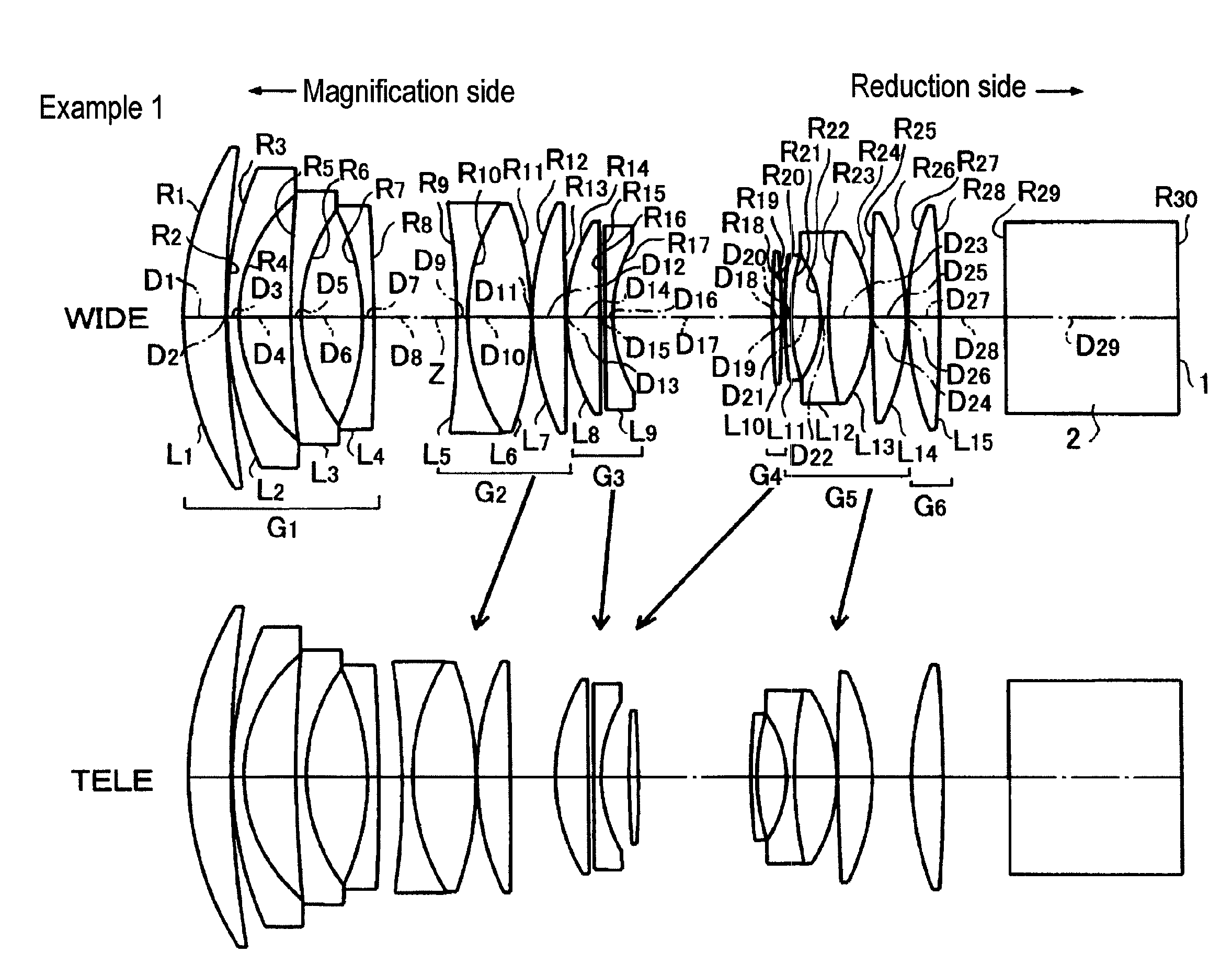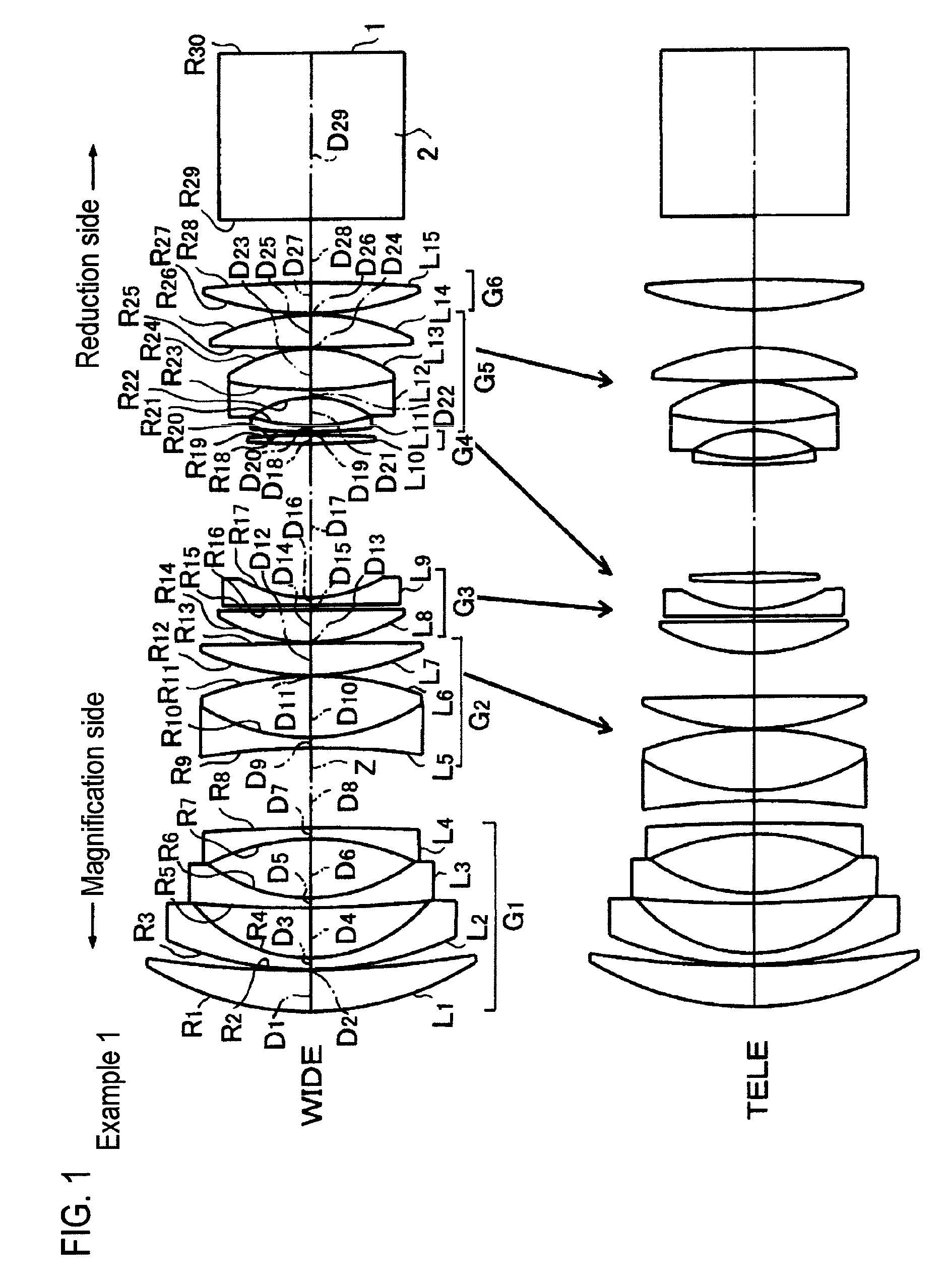Projection zoom lens system and projection type display apparatus
a projection zoom and lens system technology, applied in the field of projection zoom lens system and projection type display apparatus, can solve the problems of large spherical aberration accompanied by zooming, large marginal ray fluctuation, and increase in astigmatism, so as to reduce astigmatism, reduce marginal ray fluctuation, and effectively correct marginal rays
- Summary
- Abstract
- Description
- Claims
- Application Information
AI Technical Summary
Benefits of technology
Problems solved by technology
Method used
Image
Examples
example 1
[0056]FIG. 1 shows the schematic configuration of the projection zoom lens system according to Example 1. The projection zoom lens system includes, in order from the magnification side, a first lens group G1 having a negative refractive power, a second lens group G2 having a positive refractive power, a third lens group G3 having a negative refractive power, a fourth lens group G4 having a positive refractive power, a fifth lens group G5 having a positive refractive power, and a sixth lens group G6 having a positive refractive power. The lens system is nearly telecentric on the reduction side.
[0057]Here, the first lens group G1 includes, in order from the magnification side, a first lens L1 formed of a positive meniscus lens having a convex surface directed to the magnification side, a second lens L2 formed of a negative meniscus lens having a convex surface directed to the magnification side, a third lens L3 formed of a negative meniscus lens having a convex surface directed to the...
example 2
[0067]FIG. 2 shows the schematic configuration of a projection zoom lens system according to Example 2. The projection zoom lens system includes, in order from the magnification side, a first lens group G1 having a negative refractive power, a second lens group G2 having a positive refractive power, a third lens group G3 having a negative refractive power, a fourth lens group G4 having a positive refractive power, a fifth lens group G5 having a negative refractive power, and a sixth lens group G6 having a positive refractive power. The lens system is nearly telecentric on the reduction side thereof.
[0068]Here, the first lens group G1 includes, in order from the magnification side, a first lens L1 formed of a positive meniscus lens having a convex surface directed to the magnification side, a second lens L2 formed of a negative meniscus lens having a convex surface directed to the magnification side, a third lens L3 formed of a biconcave lens, and a fourth lens L4 formed of a biconca...
example 3
[0077]FIG. 3 shows the schematic configuration of a projection zoom lens system according to Example 3. The projection zoom lens system includes, in order from the magnification side, a first lens group G1 having a negative refractive power, a second lens group G2 having a positive refractive power, a third lens group G3 having a positive refractive power, a mask 3, a fourth lens group G4 having a positive refractive power, a fifth lens group G5 having a negative refractive power, and a sixth lens group G6 having a positive refractive power. The lens system is nearly telecentric on the reduction side.
[0078]Here, the first lens group G1 includes, in order from the magnification side, a first lens L1 formed of a positive meniscus lens having a convex surface directed to the magnification side, a second lens L2 formed of a negative meniscus lens having a convex surface directed to the magnification side, a third lens L3 formed of a negative meniscus lens having a concave surface direct...
PUM
 Login to View More
Login to View More Abstract
Description
Claims
Application Information
 Login to View More
Login to View More - R&D
- Intellectual Property
- Life Sciences
- Materials
- Tech Scout
- Unparalleled Data Quality
- Higher Quality Content
- 60% Fewer Hallucinations
Browse by: Latest US Patents, China's latest patents, Technical Efficacy Thesaurus, Application Domain, Technology Topic, Popular Technical Reports.
© 2025 PatSnap. All rights reserved.Legal|Privacy policy|Modern Slavery Act Transparency Statement|Sitemap|About US| Contact US: help@patsnap.com



